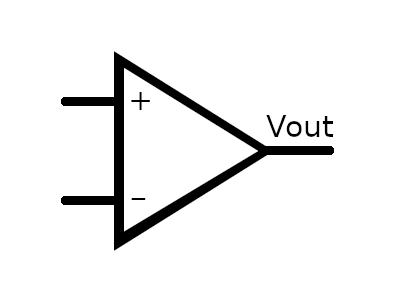Add power to activate. Active components require a power source to affect a circuit.
Operational amplifiers (op amps) are a basic component used for a variety of voltage manipulation purposes. The standard configuration for an op amp has one noninverting input, one inverting input and an output. An inverting input will produce the opposite voltage that it is supplied. In other words, if you connect a +5V signal to the inverting input (and nothing else is connected to the op amp), you will get -5V (roughly) at the output. And, of course, if you connect a +5V to the noninverting input (and nothing else is connected to the op amp), you will get roughly +5V at the output (see “rail-to-rail” below).

Note that there is no standardized convention for the arrangement of inverting and noninverting inputs in an op amp schematic. Sometimes you’ll see the inverting input at the top; sometimes at the bottom. It’s generally drawn the way that makes the most sense for the overall circuit, so always pay attention to the + (noninverting) and – (inverting) signs in the schematic.
Paired with resistors in various configurations, an op amp can amplify voltage, divide voltage down or act as a unity gain (meaning that the input and the output are identical–this is useful for circuits where you need a consistent voltage at a stage where otherwise the circuit would draw down the input voltage below desired levels). Though some ICs have only a single op amp on the chip, most come in either a dual (8-pin form factor) or quad (14-pin form factor) configuration.
An op amp that is advertised as “rail-to-rail” means that the signal “swings all the way to the supply voltage rails”. In other words, you have access to voltages closer to the supply voltage, because these op amps lose less signal to heat and entropy. If you’re running on a 9V power supply and you need your op amp to output a signal as close to 9V as possible, you’ll need a rail-to-rail op amp.
Dual-supply op amps require both a positive and negative voltage source. Single-supply op amps require only a positive power supply. Some op amps can operate as dual or single-supply circuits, where one pin can act as either ground or the negative voltage.